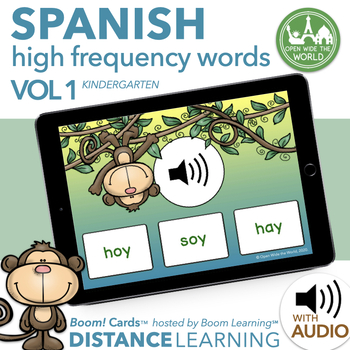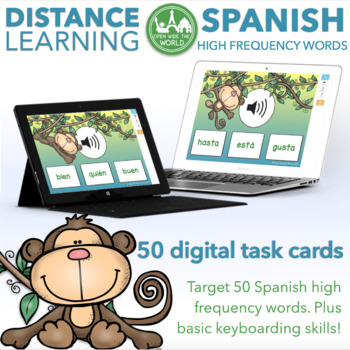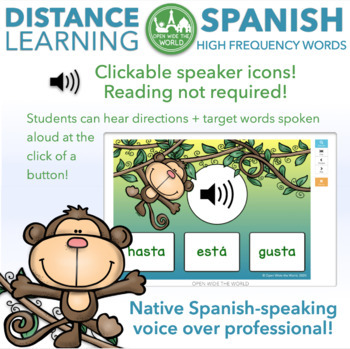SPANISH Kindergarten High Frequency Words Volume 1 Boom Cards™
- PDF
- Internet Activities
What educators are saying
Description
Palabras de alta frecuencia - Spanish high frequency words (aka sight words), Volume One. Designed for distance learning or classroom practice, this set of 50 digital cards, called Boom Cards™, targets SPANISH words that Kindergarteners must master with automaticity. All in a cute and fun monkey theme!
These digital cards are ideal for native Spanish-speaking kindergarteners as well as Spanish dual language/immersion kindergarten students.
With audio!
Each card includes a clickable speaker icon which speaks the target word aloud. Students then click to select the correct written word from three options. (All three options are from the list of 50 target words; no extraneous foils or non-words are introduced.)
Included words:
al, aquí, bien, buen, con, cuándo, de, del, día, dice, dijo, dónde, el, ella, en, es, está, estoy, fue, gusta, hasta, hay, hoy, la, las, me, mi, mucho, muy, no, papá, para, pero, por, porque, qué, quién, se, sí, soy, su, también, tengo, tiene, tú, un, una, veo, y, yo
Don't miss!
Spanish Kindergarten High Frequency Words, Volume 2 Boom Cards
Spanish Medial Sounds Boom Cards sonidos mediales
Designed to target:
CCSS.ELA-LITERACY.RF.K.1.B
CCSS.ELA-LITERACY.RF.K.3.C
CCSS.ELA-LITERACY.RF.K.3.D
* * * * * * * * * * * * * * * * * * * * * * * * * * * * * * * * * * * *
How are Boom Cards™ accessed and played?
This “deck” of digital cards is hosted on the Boom Learning℠ platform.
- Teacher/parent/purchaser will need a Boom Learning account - FREE and paid options available.
- Students need tablet, computer, Chromebook, or laptop with modern internet browser (2017 or newer, e.g., Chrome, Safari, Firefox, Edge).
It is NOT necessary to download an app to play this deck. However, if you would like to use an app, they are available for FREE for Apple, Google, and Kindle devices.
How do I download or access these materials?
After purchase, download a PDF (just like you would any other TpT purchase). Inside the PDF, you will find directions and a link. Clicking the link redirects you to Boom Learning's website.
If you already have a Boom account, this deck will be automatically added to your library when you click the link. If you do not yet have an account, you will be prompted to set up an account when you click the link.
- FREE accounts include the ability to generate student progress reports for up to 5 students. No credit card info is required for this FREE account.
- FREE accounts allow you to assign Boom Cards to unlimited students (but without progress reports). To do so, use the Fast Play pin option, available in the Library.
- A PREMIUM account is necessary for more extensive assignment and progress-tracking options.
REMINDER: This deck of digital task cards is hosted on the Boom Learning website.





